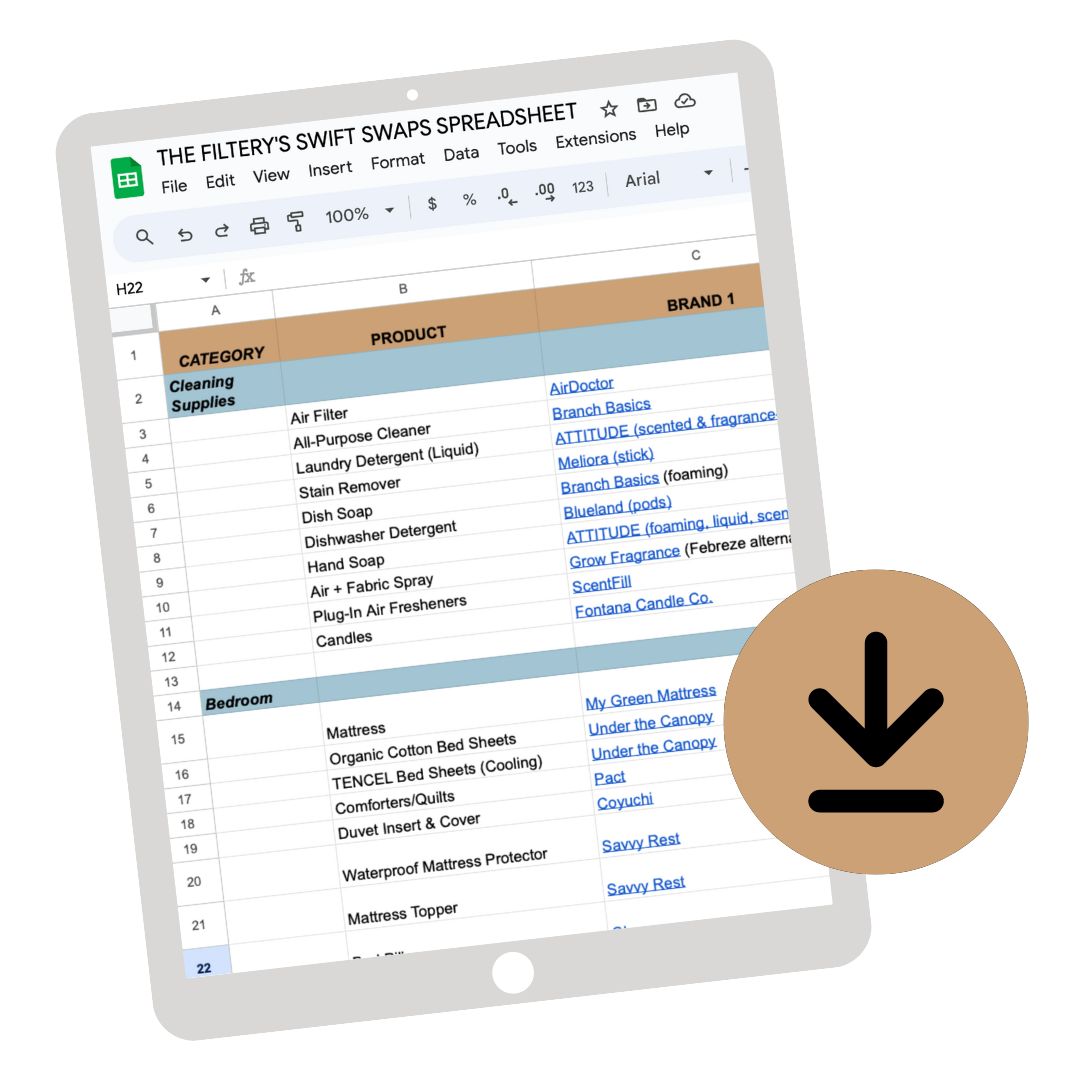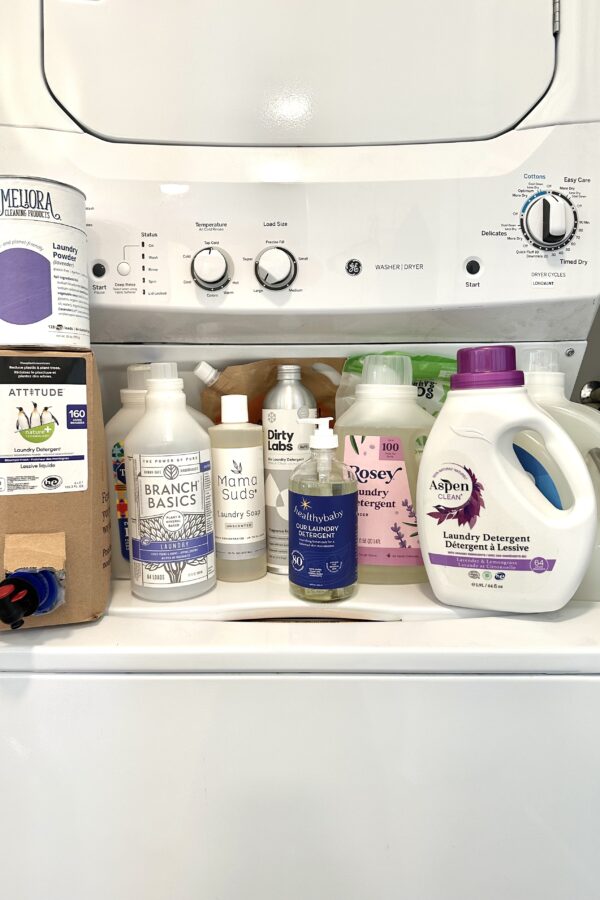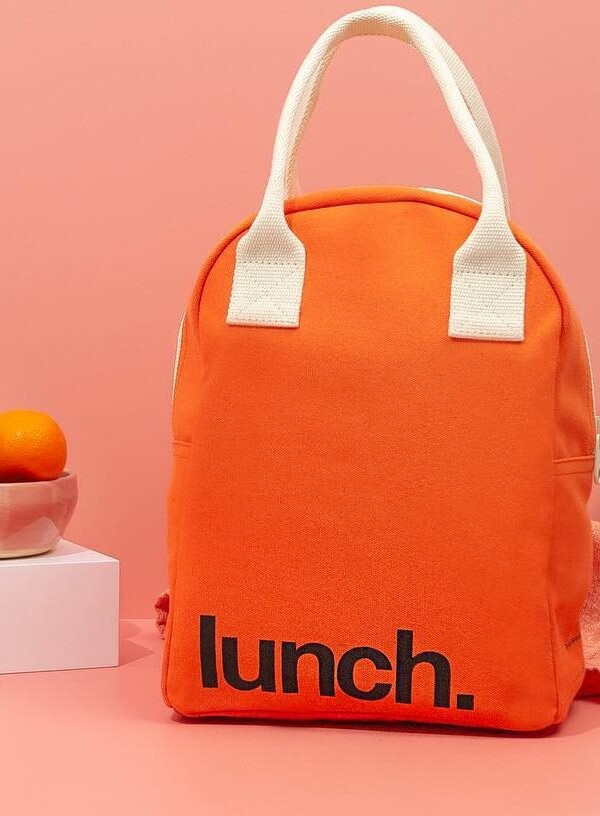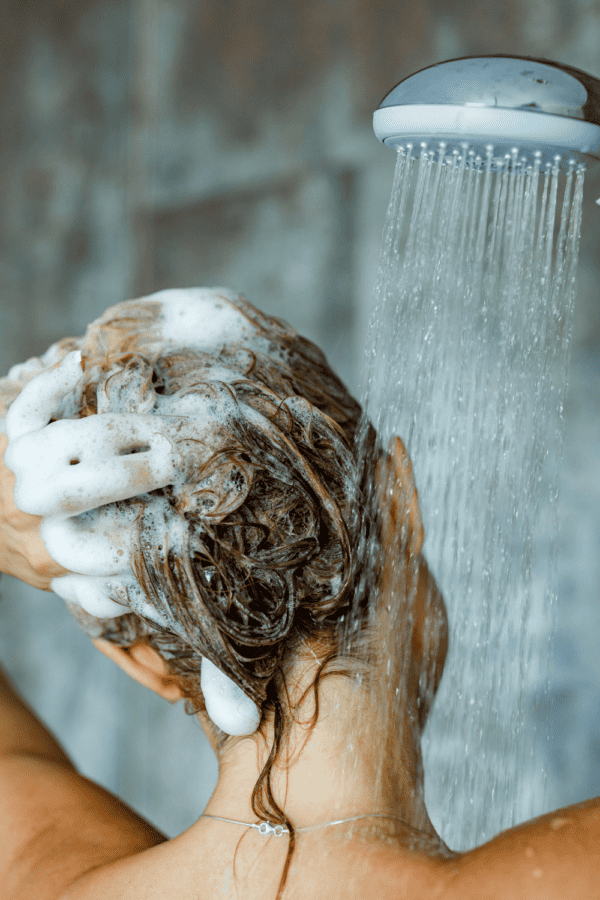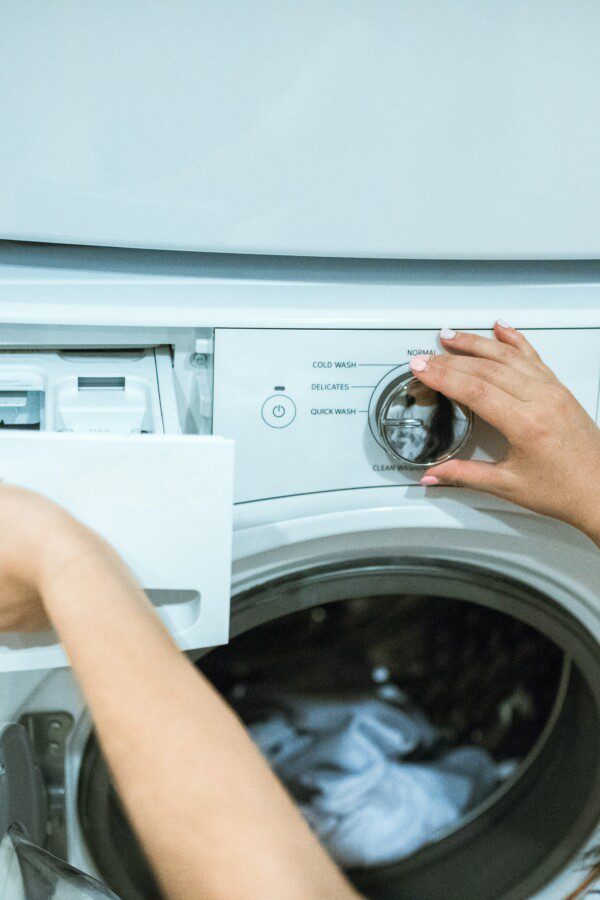With the growing availability of non-toxic products, it’s becoming easier than ever to reduce the environmental toxins in your everyday life.
I know not everyone likes New Year’s resolutions, but if you like setting goals and intentions, this article is for you. Today, I’m sharing 14 ways to decrease toxins in the New Year!
I recommend choosing just one thing to focus on, especially if you’re new to the world of low-tox living. That way, you’re more likely to stick with it and achieve your goals.
Table of Contents
- What are Toxins?
- BPA & Other Bisphenols
- PFAS
- Parabens
- Pesticides
- Phthalates
- Fragrance
- Formaldehyde or Formaldehyde Releasers
- Lead
- 14 Ways to Decrease Toxins in the New Year
- 1. Opt for Non-Toxic Personal Care Products
- 2. Stick to “Clean” Cleaning Products
- 3. Focus on Food
- 4. DIY When You Can
- 5. Filter Your Water
- 6. Leave Your Shoes at the Door
- 7. Minimize Artificial Fragrances
- 8. Get More Fresh Air
- 9. Minimize Plastics
- 10. “Detox” Your Mind
- 11. Seek out Natural Fabrics
- 12. Choose Your Cookware Strategically
- 13. Choose Furniture Carefully
- 14. Acquire a Green Thumb
What are Toxins?
Across nearly every category of store-bought products, there is an abundance of chemicals to keep an eye out for. These toxins are often linked to health concerns, like endocrine disruption, developmental and reproductive harm, or even cancer.
While there is a long list of toxins to try and avoid, here are a few “biggies.” These toxins are prevalent across many categories, from skincare to house cleaning products. Here are a few common toxic chemicals to avoid whenever possible:
BPA & Other Bisphenols
BPA has been linked to infertility in both men and women. Exposure to BPA during pregnancy has even been linked to fertility issues later in the baby’s life. Avoiding plastics wherever you can is a good idea (studies have found that even some BPA-free plastics may also disrupt endocrines). But when that’s not realistic, it’s especially important to stay away from BPA when you can.
PFAS
Per- and polyfluoroalkyl substances (PFAS) are often used to make coatings that protect products from heat, oil, grease, water, and stains. They’re found in a wide variety of products, including non-stick kitchenware, water-resistant clothing, and even food wrappers. PFAS have been linked to infertility, liver toxicity, immune system issues, impacted development, and cancer.
Parabens
Parabens (like methylparaben, butylparaben, propylparaben, and ethylparaben) are often used as preservatives in personal care products. Parabens are endocrine disruptors that have been linked to tumors and breast cancer, problems with fetal development, depression, and reduced fertility.
Pesticides
Pesticides, as you probably already know, are commonly used to kill insects, weeds, and fungi. Because they’re applied to crops, they’re often found in food. Non-organic produce often contains high levels of pesticides, which are linked to miscarriages, birth defects, and reduced learning and development among children.
Phthalates
Phthalates are commonly in fragranced products as well as flexible plastics. These endocrine-disrupting chemicals have been linked to infertility, breast cancer, pregnancy complications, and reduced childhood development.
Fragrance
“Fragrance” (or parfum) is frequently used in household staples like cleaning or personal care products. Companies aren’t required to disclose what’s in the fragrance on their ingredient label. What’s listed as fragrance can include toxins that have been linked to cancer, infertility, and other health concerns.
Formaldehyde or Formaldehyde Releasers
Formaldehyde is carcinogenic, and exposure has also been shown to affect fertility. Along with formaldehyde itself, it’s important to be aware of formaldehyde-releasing ingredients, which are used in personal care and cleaning products and release small amounts of formaldehyde over time. These include quaternium-15, sodium hydroxymethylglycinate, DMDM hydantoin, diazolidinyl urea, imidazolidinyl urea, polyoxymethylene urea, and bromopol.
Lead
Found in products like old paint and imported or antique toys, lead is linked to various health effects. The potential health effects of lead exposure include impacted growth and development, behavioral and learning issues, and damage to the brain and nervous system.
14 Ways to Decrease Toxins in the New Year
Here are some simple ways to decrease toxins in your day-to-day this upcoming year. When it comes to making lifestyle changes, it’s important to remember that nobody is perfect. Do what you can, make informed purchases, and try not to stress about the small things. Making little tweaks to your everyday choices will make a huge difference… So take it one baby step at a time!
1. Opt for Non-Toxic Personal Care Products
Whether your beauty regimen consists of an extensive list of products or a short lineup of your ride-or-dies, the ingredient lists in your everyday routine matter. Keeping your personal care products clean will significantly decrease the toxins that you’re exposing yourself to daily. The EWG Skin Deep Database is a helpful resource to check the toxicity of your beauty cabinet and discover safer products.
2. Stick to “Clean” Cleaning Products
If you use conventional cleaning products in your home, you may be inhaling and ingesting things like allergens, carcinogens, and/or endocrine disruptors.
Consider swapping out the harsh chemicals and toxic fumes for “clean” cleaning products.
Or if DIY is your thing, you can make your own! Simple ingredients like baking soda and vinegar can be transformed into inexpensive, safe cleaning products that effectively scrub away dirt and grime.
3. Focus on Food
They say you are what you eat… Making informed decisions in the grocery store can have a major impact on your health. One place to start is by getting familiar with the Dirty Dozen list, which indicates what types of produce are more likely to be contaminated by pesticides.
Although it’s not always realistic, buying organic fruits and vegetables when you’re able can help decrease your exposure to toxic pesticides, which are linked to various chronic health effects.
When it comes to meat, opt for grass-fed cuts and free-range organic eggs if you can. Free-range and grass-fed translates to animals that live happier lives without being fed harmful antibiotics or hormones.
You may also want to limit the amount of groceries with long, unfamiliar ingredient lists. Usually, more simplistic and minimally-processed foods tend to be healthier.
You may even want to shop from local farmers’ markets and support small businesses. This is another way you can have more transparency about where the food on your dinner plate is coming from.
4. DIY When You Can
This is a simple (and cheap) way to decrease toxins from your everyday routine. Whether you make your own cleaning products or use simple ingredients like coconut oil to remove your makeup, using bare-bones recipes as everyday solutions is an easy health hack.
I know it’s not everyone’s thing, but DIY products are often less expensive and can be an easy way to avoid the long and unfamiliar ingredient lists that line the shelves of most stores.
5. Filter Your Water
Unfiltered tap water often contains PFAS, lead, and other contaminants (at least 45% of American homes have PFAS in their tap water!).
To decrease toxins from your water, be mindful of what could be in it. Consider using a water filter to help remove bacteria, lead, PFAS, and other toxins.
6. Leave Your Shoes at the Door
This is an easy one! Implementing a shoe-free home in the new year can help to protect your health and decrease toxins in your home. Staying barefoot indoors (or socked, of course!) can help to reduce the spread of germs, pesticides, dirt, lead, pollen, and dust inside. This is a super easy (and free) way to reduce toxins in your home.
7. Minimize Artificial Fragrances
Mystery ingredients (including potentially harmful ones) are abundant in many scented products… Which is why some people choose to avoid artificially fragranced items altogether.
Keep an eye on candles, room fresheners, cleaning products, and any other scented products that could be putting your health at risk. If you’re looking for a fragrance, opt for companies that provide complete ingredient transparency.
8. Get More Fresh Air
Believe it or not, the air inside most homes is more polluted than outside air (even in major cities). Circulate fresh air into your home by opening your windows to get solid airflow. This is another free and easy step you can take!
You may also want to consider getting an air filter if possible to freshen up the air quality inside your home.
And of course, getting outside regularly is good for your physical and mental health, too!
9. Minimize Plastics
Plastics are, unfortunately, pretty much everywhere nowadays. However, when possible, try to use plastic alternatives to decrease toxins in your life. Here are some simple ways to decrease plastic use (especially single-use plastic):
- Hydrate with a reusable water bottle rather than drinking from plastic.
- Buy fruits and vegetables that aren’t wrapped in plastic if possible.
- When it comes to food storage, go for glass or other low-plastic options where you can.
Luckily, more and more companies are coming out with plastic-free packaging for the health of both the consumer and the planet.
10. “Detox” Your Mind
This may not technically be about chemicals, but it’s important to decrease “toxins” from your mind to protect your mental health.
This year, you may want to try to eliminate or minimize habits that negatively impact your mindset. Of course, this is going to look different for everyone. Take some time to think about, identify, and write down what brings you joy and what takes away from your joy.
Is there an app on your phone that may be helpful to delete? Is there someone in your life you may want to put boundaries around? Or maybe there is something you want to add to your mental health routine, like journaling or meditation. Think about ways that you could the most of your days in 2024!
11. Seek out Natural Fabrics
Assess what’s in your wardrobe to decrease toxins in your day-to-day. Clothing and bed sheets can often contain chemicals like PFAS, formaldehyde, and other harmful toxins (some of which are added intentionally, and others that are contaminants).
Fabrics like polyester, vinyl, and acrylic are common offenders. So, when shopping for new textile items, opt for natural fabrics like cotton, linen, or hemp. We have a lot of guides and resources in our wardrobe section!
12. Choose Your Cookware Strategically
Non-stick pans may be slightly more convenient for your morning eggs, but their coating typically contains PFAS. Rather than using non-stick cookware, stick to cast iron or stainless steel pots and pans. Or, if you really love your non-stick pans, you can go with ceramic instead. It has its pros and cons, but it’s definitely a safer option than PFAS.
Depending on what type you choose, swapping out cookware can be expensive. If this isn’t an option in the short term, cooking on lower heat (below 400 degrees Fahrenheit) and opening your windows can help reduce your PFAS exposure and the overall threat to your health.
Home
How to Choose the Best Non-Toxic Cookware (2024)
There may not be a 100% *perfect* kind of non-toxic cookware, but this guide will help you figure out the best fit for you based on your needs and preferences.
13. Choose Furniture Carefully
If you’re looking to make any major home furnishing purchases in 2024, be selective. Upholstered furniture commonly contains PFAS coatings, and wooden furniture often contains urea-formaldehyde (UF) glues.
Purchase furniture made from natural materials when you can, and research what your furniture is made of before buying. Here is our guide to some of the safest furniture brands.
Home
9 Best Non-Toxic Furniture Brands for Your Healthy Home (2024)
In this guide, you’ll learn about what to look for in non-toxic furniture brands, and then we’ll give your our favorite brands to shop from that are using the safest non-toxic materials.
14. Acquire a Green Thumb
House plants are a (potentially!) good way to freshen up not just the vibe of your home, but also the air quality. This NASA study found that houseplants effectively removed toxic particles like formaldehyde from the air inside of a sealed chamber. While there’s debate on whether or not this data translates to larger indoor spaces, house plants have also been shown to boost productivity and speed up recovery from illnesses. If a green thumb isn’t in your DNA, get a low-maintenance option (like a snake plant).
If you’re on a mission to decrease toxins in the new year, small steps can lead to big improvements. Focus first on simple swaps where you can: create DIY products from ingredients you already own, or replace your next product with a non-toxic alternative when you run out. Making intentional choices will slowly transform your habits and help lower the impact of toxins in your day-to-day life. Before you know it, you will have phased out a huge chunk of encvironmental toxins from your daily life!
